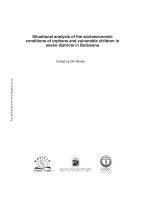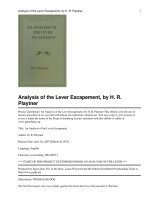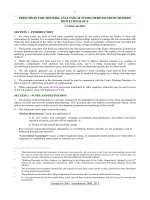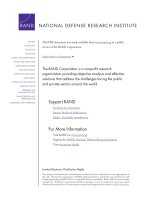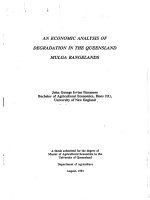Molecular analysis of the breeding biology of the asian arowana (scleropages formosus)
Bạn đang xem bản rút gọn của tài liệu. Xem và tải ngay bản đầy đủ của tài liệu tại đây (3.52 MB, 184 trang )
1 | P a g e
Molecular Analysis of the Breeding Biology
of the Asian Arowana (Scleropages formosus)
by
Chang Kuok Weai Alex
Thesis submitted in partial fulfillment
of the requirements for the degree of
Doctor of Philosophy
Department of Biological Science
National University of Singapore
2010
Supervisor: Associate Professor Laszlo Orban
PhD committee members : Emeritus Professor Lam Toong Jin
Dr Hong Yan
Dr Gregory Jedd
Associate Prof Laszlo Orban
2 | P a g e
Acknowledgements
Throughout my project, Prof. Laszlo Orban, my supervisor, was generous with his
time and knowledge and on target with his counsel and instilling in me a real
appreciation for the scientific method. . I gratefully acknowledge the essential
contributions of my Supervisory Committee, Emeritus Professor Toong Jin Lam
(chair), Dr Yan Hong and Dr Gregory Jedd, and I also thank Professor Lam for
chairing my Examination Committee. I commend the administration of the Temasek
Life Sciences Laboratory (TLL) and Qian Hu Fish Farm for facilitating the
educational pursuits of their employees I also thank Yap Kim Choon and his staff at
Qian Hu Fish Farm believing in me and providing me such a important platform to
work on this wonderful species and I am grateful to Kenny Yap for providing
invaluable early assistance.
I am grateful to my colleagues, Woei Chang Liew, Hsiao Yuen Kwan, Rajini
Srineevasan, Felicia Feng, Dr. Xingang Wang, Dr. Richard Bartfai for help and
collaborative work; and to Chin Heng Goh, Dr. Patrick Gilligan, and Dr. Gen Hua
Yue, who quickly and patiently replied to questions relating to material herein. I thank
the contribution of several attachment students, Wee Kee, Qi Feng, Zi Jie, Say Aik,
Serene, and Daniel who brightened up the sky every time they were around. In
addition, I fondly acknowledge the help and support of numerous TLL colleagues and
PIs. Also, special thanks to Dr Robert Brooks, who patiently guided me through the
advanced analysis of some of my results (in understanding mating systems. I also
thank Aaron Chuah and Graham Wright, who provided computing advice and code,
Prof Rudolf Meier and Prof Tan Heok Hui, who helped me in understanding the
interesting phylogenetic studies.
Lastly, I thank my Dad for getting me hooked on fishes and fisheries science early on.
3 | P a g e
Dedication
To my family, especially my dad and mum, my wife Cynthia, my son Andre Jacob and
friends, for their unwavering kindness, patience, and support.
4 | P a g e
TABLE OF CONTENT
ABSTRACT 11
List of Tables 12
List of Figures 13
List of Abbreviations 23
1 INTRODUCTION 27
1.1 Taxonomy of bonytongues 27
1.2 The general biology of Asian arowana 31
1.3 The Asian arowana has at least six main colour strains 34
1.4 Sex and strain identification of teleosts using classical tools 42
1.5 Mating system and parental care in fishes 46
1.6 Molecular approaches in fish biology and aquaculture research 50
1.7 The aims of my research 62
2 MATERIALS AND METHODS 63
2.1 The origin of fish studied 63
2.2 Arowana breeding and holding facilities in QH 64
2.3 Field Observations 64
5 | P a g e
2.4 Sample collection 65
2.5 DNA isolation 66
2.6 Isolation and genotyping of microsatellites 68
2.7 Detection of steroid hormone levels using an Enzyme Immunosorbent Assay
kit …………………………………………………………………………… 69
2.8 Bradford total soluble protein (TSP) Assay 69
2.9 Amplified Fragment Length Polymorphism (AFLP) 70
2.10 Fluorescent Motif Enhanced Polymorphisms (FluoMEP) 72
2.11 Determining single nucleotide polymorphisms in the mitogenome to
confirm the gender of the mouthbrooder 72
2.12 Computational and statistical analysis 74
2.12.1 Microsatellite genotyping 74
2.12.2 Analysis of AFLP-based phylogenetic relationship between the colour
strains …………………………………………………………………………75
2.12.3 Analysis of kinship between the brooders for understanding egg thievery
event …………………………………………………………………………75
2.12.4 Study of the genetic similarity among the colour strains 76
2.13 Morphometric measurements 76
6 | P a g e
2.13.1 External morphometric differences 76
2.13.2 Internal morphometric differences – moulding/roughness index and
touch-based examination 77
2.13.3 Morphometry of the eggs and larvae 79
3 RESULTS 80
3.1 The reproduction biology of Asian arowana is very different from that of
most teleosts 80
3.1.1 Observation of mating - temporal and spatial data 80
3.2 Differences in the productivity and survival rate of colour strains and
dependence of breeding events on environmental factors 84
3.2.1 There were significant differences in offspring number per brooder and
their survival between several colour strains 84
3.3 The early development of Asian arowana larvae is a slow process 87
3.3.1 Fertilised eggs 88
3.3.2 Juveniles 89
3.4 Sexing the brooders with classical and molecular tools 91
3.4.1 External morphometric measurements on sexually mature adults showed
significant differences between the two sexes 91
7 | P a g e
3.4.2 Internal morphometry – The surface of the buccal cavity transformed in
mouthbrooding males 92
3.4.3 Hormonal measurements from mucus 95
3.5 Identification of the sex of the mouthbrooding parent in the MG variety of
Asian arowana 96
3.6 Genotyping data reveals complex relationships between the brooders in the
ponds …………………………………………………………………………… 99
3.7 Change in breeding pattern following the loss of a male in pond WH001 105
3.8 No signs of possible inbreeding or incompatibility avoidance were observed
…………………………………………………………………………….106
3.9 The Asian arowanas display an unusual phenomenon of egg thievery 107
3.10 Transient morphological modification of the surface of buccal cavity in
Asian arowana during mouthbrooding 111
3.11 Most colour variants of Asian arowana can be differentiated from the
others using molecular analysis 113
3.11.1 Differentiation of the colour strains using microsatellite-based
genotypes 113
3.11.2 FluoMEP was able to differentiate between two commercially important
colour strains 115
8 | P a g e
3.11.3 The microsatellite-based phylogenetic tree of the colour variants of
Asian arowana was congruent with geographical reconstruction of prehistoric
events in South-East Asia 117
3.11.4 Bayesian clustering analysis allowed for differentiation of most colour
strains ……………………………………………………………………… 119
3.12 Pairwise comparison of the F
ST
value indicated that the colour strains are
likely to be one species 121
4 DISCUSSION 123
4.1 Microsatellites allow for accurate parentage analysis and reveal breeding
relationships of Asian arowana 123
4.2 The Asian arowana male protects its eggs by transient morphological
modification of the surface of its buccal cavity during mouthbrooding 130
4.3 The advantages of being able to sex the adult Asian arowanas 132
4.4 The change in the breeding relationships in a pond after the death of a highly
productive male indicates the presence of a complex hierarchical breeding system
…………………………………………………………………………….138
4.5 Our data do not show inbreeding or incompatibility avoidance, indicating
unique mate choice and strategy 139
4.6 Egg thievery: Why do Asian arowanas steal each other‟s eggs? 141
9 | P a g e
4.7 Asian arowanas provide another example for a positive correlation between
egg size and parental care 144
4.8 Genetic confirmation of a paternal care in the Malaysian golden variety of
Asian arowana 145
4.9 Strong positive effect of a mating strategy involving multiple mates, number
of reproductive events (broods) and lack of difference between the sexes 146
4.10 Genetic analysis detects distinct differences between Asian arowana
strains ………………………………………………………………………….150
4.11 The divergence of the different colour strains seems to be consistent with
the change of the land mass configuration of South East Asia 152
4.12 The different colour strains are likely to be geographically isolated
populations and not different species 154
5 POSSIBILITIES FOR THE FUTURE 156
5.1 Selective breeding program – production of the first hybrids in preparation
for linkage mapping 156
6 REFERENCE 158
7 SUPPLEMENTARY TABLES 178
10 | P a g e
ABSTRACT
The dragonfish or Asian arowana (Scleropages formosus Müller & Schlegel, 1844) is
one of the few living, „near-basal‟ teleosts belonging to the family Osteoglossidae.
This CITES-protected species possesses a fascinating collection of biologically
interesting characters that could be important for the study of basal vertebrate
breeding biology, mating behavior and mate preference. We report here, to the best of
our knowledge, the most detailed documentation of the breeding behavior, including
mate choice and observed mating strategy, of S. formosus. For the analysis of mate
choice, we created the “genetic mating map” for three ponds containing the total of
more than 60 brooders over a 3 yr period, using 12 highly polymorphic
microsatellites. Our data indicated that there were no multiple paternities, only single
paternity in the 100 clutches of offspring sampled. The interspawning interval ranged
from 2 months to 17 months. Parentage assignment, together with identification of the
maternal and paternal genotypes using mitochondrial haplotyping, demonstrated that
Asian arowana practiced both polygamy and monogamy. We also reported the
unusual form of egg thievery practiced by the Asian arowana and a transient
modification of the buccal cavity in the male brooders in preparation for the
mouthbrooding event.
Our data are important not only for better understanding the breeding biology of this
unusually interesting bonytongue, but also for their potential to improve the existing
aquaculture programs.
11 | P a g e
List of Tables
Table 1: Members of the family Osteoglossidae and their geographical distribution . 30
Table 2: The different colour strains of Asian arowana found across the islands in
Southeast Asia and one of their hybrids 37
Table 3:The mating systems and types of parental care observed in the family
Osteoglossidae are variable 49
Table 4: Types of DNA markers, their characteristics and potential applications. 52
Table 5: The productivity and offspring survival of different colour strains in the farm
85
Table 6 : The modification of buccal cavity surface is transient and occurs in
mouthbrooding males only. 95
Table 7: The mitochondrial gene-based SNP profiles of the offspring are identical
with those of their non-mouthbrooding genetic parent 98
Table 8: Characterization of microsatellites and genetic diversity in 230 Asian
arowana brooders 103
Table 9: Average F
ST
values of the different colour varieties of Asian arowana and
two Australian arowana species 122
Table 10: The fecundity of some females from WH001 130
12 | P a g e
List of Figures
Figure 1: The phylogenetic analysis of the Osteoglossids and other teleosts by using
concatenated mitochondrial protein-coding genes. The data set consist of a total of
3,675 amino acid positions concatenated from 12 protein sequences for each species.
The phylogenetic relationship of Asian arowana with repect to representatives from
Actinopterygii and Sarcopterygii taxa using dogfish shark as outgroup was performed
by maximum parsimony (MP), maximum likelihood (ML) and Bayesian interferences
(BI) methods. Tree topology produced by the different methods was similar.
Bootstrap values are in parentheses and in MP/ML/BI order. Diagram obtained from
figure 5 of Yue et al., BMC Genomics 7:242 , 2006; [10]. 28
Figure 2: The seven members of the Osteoglossidae family show phenotypic
similarity. Panels: A) Arapaima; B) Black arowana; C) Silver arowana; D) African
arowana; E) Asian arowana; F) Pearl arowana; G) Red spotted arowana. 29
Figure 3: The architecture of the Asian arowana‟s buccal cavity and the tongue bite
apparatus (TBA). TBA is thought to be a derived feature of the Osteoglossomorpha
used for anchoring the prey to the buccal cavity. Labels: A) Teeth on the medial edge
of entopterygoid; B) Basihyal/basibranchial toothplate. 34
Figure 4: The colour varieties are located in different geographical locations in
Southeast Asia. Labels: RG1 – Red Grade 1 (red); MG – Malaysian Golden (blue);
IG- Indonesian Gold (brown); RG2 – Red Grade 2 (black); GR- Green (green); Other
than the GR, the other colour varieties are endemic only to one geographical location.
The GR is found in Cambodia, Peninsular Malaysia and Indonesia 36
13 | P a g e
Figure 5: The presence of different natural colour varieties of Asian arowana is unique
compared to the rest of the subfamily Osteoglossinae. Panels: A) RG1; B) RG2; C)
Malaysian Gold (MG); D) Indonesian Gold (IG); E) Tong Yan Hybrid (TY); F) Green
(GR). Please see Figure 4 for labels. 38
Figure 6: The juveniles of all the colour stains are phenotypically very similar. Panels:
A) RG1; B) RG2; C) MG; D) IG; E) Tong Yan hybrid (TY); F) GR. Please see Figure
4 for labels. 39
Figure 7: The scales of each colour variety contain different chromatophores which
strongly contribute to their unique phenotype. Scales of four different colour varieties
were viewed under stereomicroscope (20X magnification). Panels: A) RG1; B) MG;
C) IG; D) GR. Second set of panels with the respective close-up using a DLR
camera‟s macro function of the scales: E) RG1; F) MG; G) IG; H) GR. 40
Figure 8: Inheritance of a single microsatellite locus from the parents to their
offspring. Microsatellites are amplified by PCR, using the unique sequences of
flanking regions as primers. The amplified DNA is then detected using the 3730xl
DNA Analyzer (ABI, Foster City, CA, USA) and peak profiles were presented using a
software GeneMapper software V3.5 (Applied Biosystems). From the peak profiles,
Offspring #1 have inherited the larger allele from parent A and the smaller allele of
parent B leading to a homozygous genotype, where else offspring #2 inherited the
smaller allele of parent A and larger allele of parent B resulting in a heterozygous
genotype. 56
14 | P a g e
Figure 9: A schematic representation showing the difference between RAPD and
FluoMEP. RAPD typically uses one short, unlabelled primer (half-arrow). The
amplified band pattern is separated on agarose gel, detected by ethidium bromide
staining and analyzed by visually comparing the patterns. The typical number of
bands varies between one and a dozen. FluoMEP uses fluorescently labeled “common
primers” (half-arrow with star) with the potential ability of targeting frequent motifs
(rectangle) in the genome together with the short, unlabelled RAPD primers. The PCR
product of FluoMEP contains three different kinds of bands amplified by: i) the
common primer only; ii) the common primer and the RAPD primer together; and iii)
the RAPD primer alone. The pattern is separated by capillary gel electrophoresis, and
only the fluorescently labeled bands at one or both ends are detected. The typical
number of bands varies between 10 and 100. (Figure 1 of Chang et al.,
Electrophoresis 28; 525-534, 2007 [153]. 61
Figure 10: External morphometric measurements used when searching for phenotypic
sex markerson fully mature, adult specimen of Asian arowana. Labels; SL - Standard
Length, HL - Head Length, GPH - Gill Plate Height, GPL - Gill Plate Length, and ML
- Mouth Length. 77
Figure 11: The breeding process of Asian arowana captured on video by a hobbyist.
Panel A: During the start of the mating process, the two partners would lay close to
the bottom beside each other and swirl in a circular motion; Panel B: this swirling
movement will stop and both the fish will stay motionless for about 30 seconds and
after which there would be a coordinated release of milt and eggs (see arrowhead).
Panel C: The release of the milt and eggs, the female floats towards the surface of
15 | P a g e
water. The male would also leave the fertilized eggs and move to the surface for a
gulp of air (Panels C-D). The male slowly collected them into his mouth by gentle
suction (Panels E-F). The pictures were taken from a video publicly available at
Youtube: 83
Figure 12: The breeding cycle of the Asian arowana in the farm. The graph shows the
total production in terms of number of batches(dotted line)and number of offspring
(solid line) for the three experimental ponds in relation to the rainfall (bar) data from
January 2003 to November 2006. 87
Figure 13: The development of Asian arowana embryos, larvae and juveniles. Panels:
A) Fertilized egg at 0 dpf; B) Embryo at 3 dpf; C) Larva at 7 dpf; D) 9 dpf; E) 5 dpf;
F) 13 dpf; G) 15 dpf; H) 25 dpf; I) 28 dpf; J) Juvenile at 33 dpf; K) 36 dpf; L) 40 dpf;
and M) 45 dpf. The bar indicates 5 mm on every panel. 90
Figure 14: Significant morphometric differences between male and female individuals
of the Asian arowana. Male; Female; * = denotes significant difference between
males and females (student t test; P<0.0005); n=40; SL - Standard length; HL - Head
length; ML - Mouth Length; GPL - Gill plate Length 92
Figure 15: Scanning electron micropgraphs of the parasphenoid (pharyngeal teeth) do
not reveal differences in teeth morphology between males and females. Panels ; A -
Male; B - Female; C - Teeth that are found on the endopterygoid (relative position to
the entopterygoid teeth is indicated by the red box) of both males and females. Bars
represent 100 micron. 94
16 | P a g e
Figure 16: Smooth buccal cavity can be found only in some Asian arowana brooders.
A total of 144 brooders (sex of the fish is not determined yet) were examined for the
roughness using touch-based examination and the results were compared to their
breeding records. On the graph, a smooth surface is indicated with a green bar and
indicated as (“-”), a intermediate roughness is given a maroon bar and indicated as
“+/-”, and a rought surface is given a blue bar and is indicated as “+”. 94
Figure 17: Comparing the 11-KT levels in the mucus of males to females in pond
WH001 over a period of 26 months. Hormone levels were determined by ELISA
essay and normalized by the total soluble protein content determined by Bradford
essay. The bars show the average values with their standard deviation. 96
Figure 18: The breeding relationships of Asian arowana were complex and involved
different mating systems. The breeding relationship chart showing the connections
between the brooders in pond WH001, as revealed by genotyping with a set of highly
polymorphic microsatellites. Each boxed ID represents an individual brooder in a
pond; numbers in the top row represent mouthbrooding individuals, whereas those
immediately below the chart are non-mouthbrooding parents identified by genotyping.
The three boxed IDs in the bottom left corner indicate inactive brooders (i.e.
individuals that we have not collected any offspring from and also did not have any
breeding relationships based on genotyping since the start of the experimentation)
without known sex. Lines represent breeding connections that were determined by
microsatellite genotyping. Each circle (○) on the line represents one breeding event
that occurred between the two brooders, whereas the number beside the circle
represents the number of offspring that was collected from the mouthbrooding
17 | P a g e
individual. The column on the left indicates the date of the collection of the offspring
from the buccal cavity of the brooder. 100
Figure 19: Fewer active brooders appeared to form less complicated breeding
reelationships. The breeding relationship chart between the brooders in pond WH002.
For labels see Figure 18. 101
Figure 20: There were no monogamous pairs in the third pond. The breeding
relationship chart between the brooders in pond WH003. For labels see Figure 18 101
Figure 21: The loss of a fecund male resulted in long cessation of reproduction,
followed by rearrangements of breeding connactions pond WH001. For labels see
Figure 18. Blue lines indicate terminated breeding connections, whereas red lines
newly formed connections following the re-initiation of breeding after a half-a-year
break, black lines indicates breeding connections that are resumed following the
hyatus. 106
Figure 22: There is no correlation between the genetic similarity of female brooders
and their male breeding partners in the pond. The chart shows the dissimilarity
indices (Nei‟s genetic distances) between 4 females (A2, A6, A8 and B2) and all their
potential male breeding partners in the pond, respectively. The indices were calculated
using the software package NTSYS [166]. The red bar indicates at least one breeding
event with the female. Panels; A: Female A2, B: Female A6, C: Female A8, D:
Female B2 108
18 | P a g e
Figure 23: There is no correlation between the genetic similarity of male brooders and
their female breeding partners in the pond. The chart shows the dissimilarity indices
(Nei‟s genetic distances) between 4 males (B5, B9, A1 and C1) and all their potential
female breeding partners in the pond, respectively. The red bar indicates at least one
breeding event with the male. The indices were calculated using the software package
NTSYS [166]. Panels; A: Male B5, B: Male B9, C: Male A1, D: Male C1 108
Figure 24: Egg thievery occured in Asian arowana and in this pond all the thievery
events were linked to one female. A green line connects a mouthbrooding individual
that is mouthbrooding a batch of offspring where it is not the genetic parent; to the
genetic parents breeding event and the triangle (∆) represents the mouthbrooding
event by the “thief” (alpha numeric name encircled) and number shows the number
of offspring collected (For rest of the labels, see Fig. 18). 110
Figure 25: Kinship coefficient data of the thief and the genetic parents of stolen eggs
did not show any indication of kin selection. We tested the relatedness between pairs
of brooders available in the pond and calculates the ratio of the primary hypothesis
that they are related (full-sibs or half-sibs) to the null hypothesis that they are
unrelated. k refers to the kinship coefficient where higher k value indicates higher
chances of the pair being kin of each other (relatedness), where k of 1 indicates full
siblings while 0 shows no relation. We compared the k of the thief (male)/genetic
parents versus the ave k value amongst the brooders, we assume that if the k value of
the thief/genetic parents is higher than the ave k, then there is a possibility of kin-
selection occurring in the pond where kins are helping each other in parental care.
The grey bar indicates the k value of the thief with the genetic father where the white
19 | P a g e
bar refers to the k value of the thief with the genetic mother. The triangle symbol
shows the ave k value. 110
Figure 26: Observing the changes in the entopterygoid teeth profile of a male before,
during and after mouthbrooding by confocal microscopy-based analysis of dental
moulds. Panels: A) A planar representation of the entopterygoid teeth profile of a
male at day 0 (larvae removed after mouthbrooding); B) 42 days later (day 42); C) 3-
dimensional representation of the profile shown in A; D) 3-dimensional representation
of the profiles shown in B; E) and F) Graphical representation of the changes in
surface profile in the above male and a female, respectively. 112
Figure 27: Microsatellite data analysis was able to differentiate the colour strains into
five clusters. Dendrogram showing the cluster analysis separating the colour strains
into 5 distinct clusters according to the colour strains. Twelve microsatellite markers
were used to analyse the phylogenetic relationship between the colour strains, 219
data points were generated per individual. Cluster analysis was performed using
Neighour-Joining algorithm (NJ) using NTsys package 2.02e. An unrooted
phylogenetic tree was fitted to the chord distance matrix by using the neighbor-joining
(NJ) algorithm as implemented in MEGA (ver3.1.2). TreeView was used to visualize
the tree. The subcluster shaded in blue contains all Malaysian golden individuals. 114
Figure 28: fluoMEP assay allowed for the differentiation between the RG1 and RG2
colour variants at the genetic level. DNA samples (n =8) were collected from two
strains of Asian arowana (Red Grade 1 and Red grade 2) and they were screened
using the FluoMEP method. Panel A shows the result of primer combination
20 | P a g e
C117+BH05 with a peak at 137bp which is present in RG1 but absent in RG2. Panel
B shows the primer combination C117+F04 which produces a peak at 314bp position
for RG1 and 294bp position for RG2. 116
Figure 29: The shape of the microsatellite-based genetic distance tree of the Asian
arowana colour varieties appeared to be consistent with pre-historic geographic
events. The change in the land mass of South East Asia shows consistency with the
divergence of the different phenotype strains and their endemic location and this is
also supported by the relatively similar phenotype between the strains. Panels: A)
shows the 120m water level contour of the South East Asia land mass 17,000 yrs ago
B) 40m contour, 10,000 yrs ago and C) 20m contour, 10,000 yrs ago. D) Genetic
distance tree generated from 12 microsatellite genotypes by Neighbor-Joining (NJ)
method. The branching points labeled with 1 and 2 indicate events that separated
some colour varieties; 1 and 2 indicates the clade that is formed by the colour strains.
(Source of Paleogeographical figures – Harold K.V., 27; 1153-1157, 2000 [180]) 118
Figure 30: Bayesian clustering analysis using microsatellite and AFLP data enabled
the differentiation of most colour strains including the hybrids. Bayesian model–
based clustering method implemented
in Structure v 2.1 was used to investigate the
genetic structure of the different population [171,172] using data from 8 polymorphic
MS loci and 225 AFLP markers, this helped in the determination of the most likely
number of genetically distinct clusters (K) of populations. 120
Figure 31: The Asian arowana fits in the proposed correlation of mating system,
sexual selection in sexual dimorphism. Pictorial definitions of four genetic mating
21 | P a g e
systems possible in fishes. Lines connecting males and females indicate spawning
partners that produced offspring. Also shown are the theoretical gradients in sexual-
selection intensities and the degrees of gender dimorphism in secondary sexual traits
(epigamic features) often associated with these mating systems. (picture obtained
from Avise JC et. al. 36; 19-25, 2002 [16]. 129
Figure 32: There is an advantage in having more mates in both Asian arowana sexes.
Total offspring produced were plotted against the number of unique mating partners
and brooder has mated with and also against the number of separate broods of
offspring. Regression analysis shows that there is a strong positive effect indicating
more mates and more reproductive events (broods) equates to more offspring and
when we compared the interaction term which formally test the different regression
slopes, the effect is not different between the sexes. (This analysis was done by Dr
Robert Brooks of UNSW, Sydney Australia, using our data.) 150
22 | P a g e
List of Abbreviations
11-KT 11-ketotestosterone
AFLPs Amplified Fragment Length Polymorphisms
ANOVA Analysis of Variance
ART Alternative Reproductive Tactics
atp6 ATP synthase subunit 6
BI Bayesian Interferences
bp Basepair
CE Capillary Electrophoretic
CI Confidence Intervals
CITES Convention on International Trade in Endangered Species of Wild
Fauna and Flora
cob cytochrome oxidase b
cox1 cytochrome c oxidase subunit I
cox2 cytochrome c oxidase subunit II
cox3 cytochrome c oxidase subunit III
dNTPs Deoxynucleoside Triphosphates
dpf days post fertilisation
E2 Estradiol-17β
EIA Enzyme Immunosorbent Assay
23 | P a g e
ELISA Enzyme-Linked Immunosorbent Assay
ESA Endangered Species Act
ESTs Expressed Sequence Tags
f Coefficient index
fluoMEP Fluorescent Motif Enhanced Polymorphism
F
ST
Genetic Similarity
GPH Gill Plate Height
GPL Gill Plate Length
GR Green
GSI Gonadal Somatic Index
H Genetic diversity
He Expected heterozygosity
HL Head Length
Ho Observed heterozygosity
IG Indonesian Golden
IUCN International Union for the Conservation of Nature and Natural
Resources
k Pairwise Kinship Coefficient
KCl Potassium Chloride
MCMC Markov Chain Monte Carlo
24 | P a g e
MG Malaysian Golden
MgCl
2
Magesium Chloride
MHC Major Histocompatibility Complex
MJK Mensiku strain
ML Maximum Likelihood
ML Mouth Length
MP Maximum Parsimony
mtDNA mitochondrial DNA
nad1 NADH dehydrogenase subunit 1
nad2 NADH dehydrogenase subunit 2
nad4 NADH dehydrogenase subunit 4
nad5 NADH dehydrogenase subunit 5
NEA National Environmental Agency
NJ Neighbor-Joining
OSR Operational Sex Ratio
PCR Polymerase Chain Reaction
PIT Passive Integrated Transponder
QH QianHu
QTL Quantitative Trait Loci
RAPD Random Amplified Polymorphic DNA
25 | P a g e
RFLPs Restriction Fragment Length Polymorphisms
RG1 Red Grade 1
RG2 Red Grade 2
SL Standard Length
SNPs Single Nucleotide Polymorphisms
SSC Standard Saline Citrate
SSCP Single-Stranded Conformation Polymorphism
SSR Simple Sequence Repeat
STRs Short Tandem Repeats
TBA Tongue Bite Apparatus
TL Total Length
Tris-HCl Tris Hydrochloric Acid
TSP Total Soluble Protein
TY Tong Yan
VTNR Variable Number of Tandem Repeat
WRG1 Wild Red Grade 1


